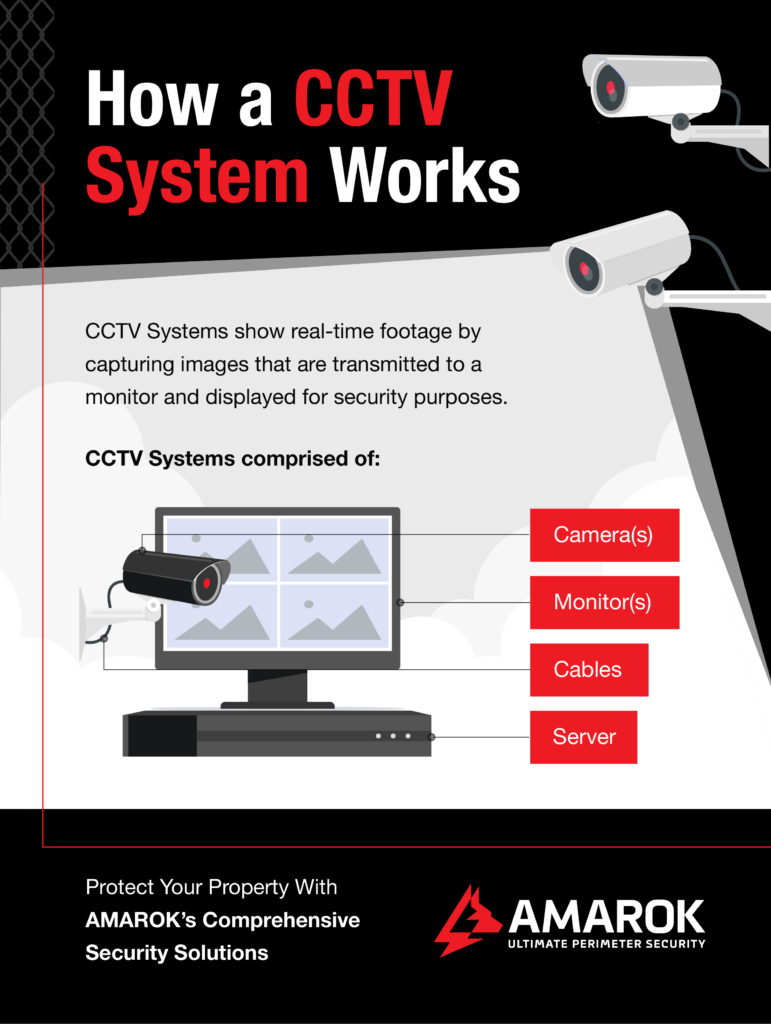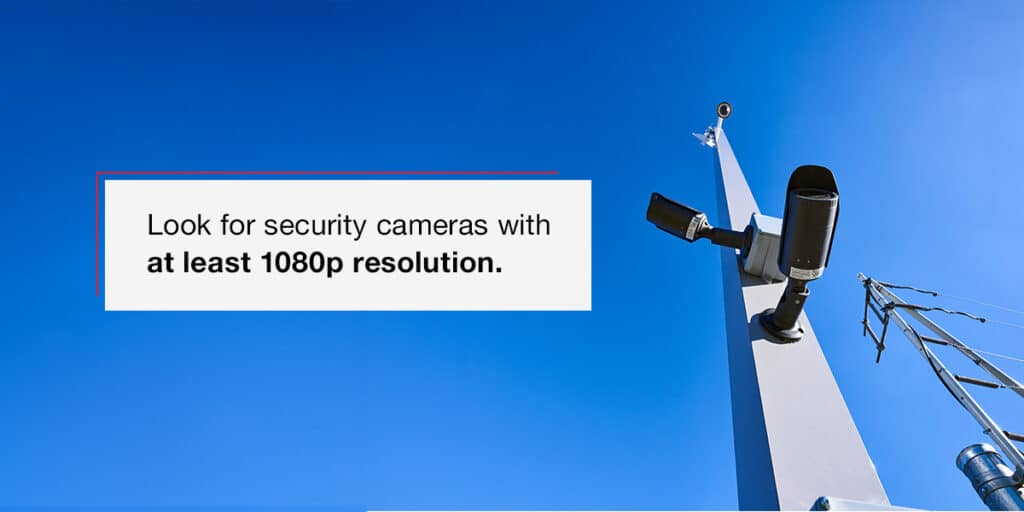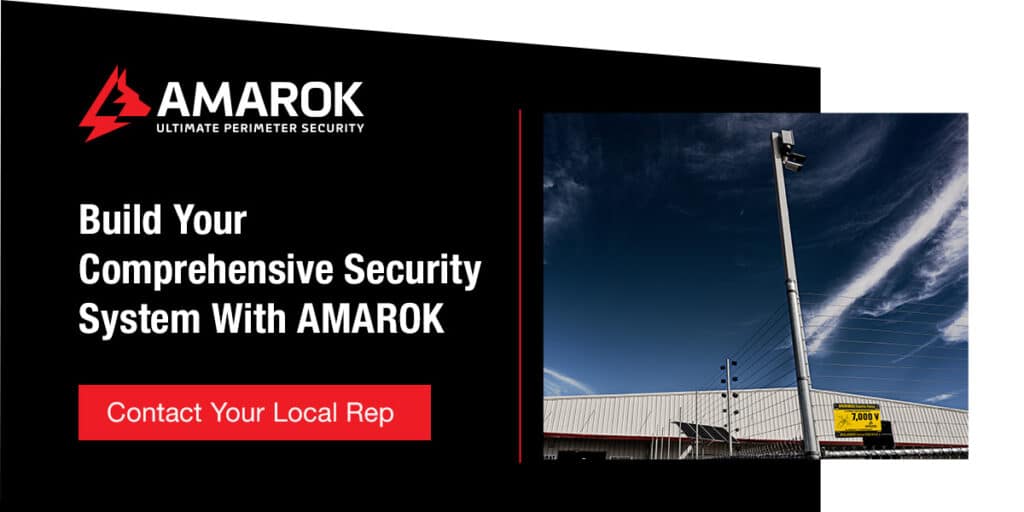Table of Contents:
- Benefits of CCTV For Property Protection
- Where is CCTV Used Most Often?
- How Does CCTV Work?
- Types of CCTV Systems
- Wireless Analog and IP Surveillance Cameras
- How Can CCTV Help Protect Your Property?
- What Makes a Good CCTV System?
- How to Tell if CCTV Is Right for You
- Build Your Comprehensive Security System With AMAROK
Closed-circuit television (CCTV) is a beneficial security-enhancing measure for various properties and industries. It provides property owners with peace of mind and helps security personnel monitor properties. When cameras are visible to potential thieves, CCTV may also deter criminal activity.
Video surveillance systems are a part of a strong security strategy. When paired with other perimeter security solutions, they can help create a safer environment. However, much goes into setting up a security system that includes CCTV. You must understand the basics of camera technology, choose a reliable option and install it properly.
What is CCTV?
CCTV uses a wired or wireless data network to transfer footage from surveillance cameras to monitors. Its origins date back to 1927 when Russian inventor Leon Theremin developed a system closely resembling CCTV. In 1966, American inventor Marie Van Brittan Brown developed a similar system, which she patented in 1969.
Benefits of CCTV for Property Protection
CCTV allows security personnel to watch live feeds on monitors or remotely access footage via mobile devices. CCTV cameras may also reduce the likelihood of theft — especially when paired with other perimeter security enhancements — and enable quicker emergency response times. Constant property surveillance offers various other benefits, including:

- Identifying thieves: On-premises CCTV can identify criminals should they break into your property. Pairing your camera with other perimeter security measures can drastically reduce theft.
- Collecting evidence: Video recordings from these systems can provide valuable evidence in the event of a crime. Law enforcement can use this footage as evidence in court proceedings.
- Monitoring and surveillance: Real-time monitoring through CCTV helps security personnel keep an eye on multiple locations simultaneously.
- Maintaining public safety: CCTV used in public spaces like airports and shopping malls can enhance security and help manage large crowds. It also empowers personnel to respond quickly to accidents, emergencies, and theft.
- Enabling remote access: With remote access to live footage, commercial property owners, security personnel and others can have peace of mind. They can quickly respond to any issues — no matter where they are.
- Promoting customer and employee safety: CCTV monitoring for workplaces can provide the evidence needed to resolve disputes by capturing an objective account of events.
Where Is CCTV Used Most Often?
A CCTV camera enhances visibility and monitoring capabilities to safeguard assets, making it an effective part of a layered security system. Strategic camera placement allows for more comprehensive surveillance and offers the opportunity to explore activities from multiple angles.
In industrial environments, CCTV is vital in overseeing daily operations to ensure compliance and promote a safe workplace. By continually monitoring areas, businesses can quickly identify safety hazards for faster intervention. CCTV can also deter theft and vandalism to create a more secure working environment.
Office buildings often use CCTV to monitor access points such as entrances and exits, as well as communal spaces. Having surveillance in place helps maintain a safe environment for employees and visitors. By using CCTV to prevent unauthorized access, businesses improve their overall security posture and gain the ability to ensure everyone on the premises is accounted for.
How CCTV Works in Building Security

At a baseline, CCTV systems consist of cameras, monitors, and devices that get the video data from one location to another. Analog cameras are standard, but digital cameras, such as internet protocol (IP) cameras, are also an option. Cameras capture video data of the monitored area and can be equipped with features like motion detection, high-definition (HD) resolution, and night vision. Some surveillance cameras even have lenses with zooming and focus capabilities.
There are two ways to transmit and store the captured data — digital video recorders (DVRs) and network video recorders (NVRs):
- Digital video recorders: DVRs are used with analog cameras. They convert the analog camera signals into a viewable digital format. You can store the footage on a hard drive or in the cloud.
- Network video recorders: NVRs are compatible with digital cameras. Unlike analog cameras, IP cameras can process video data. The processed data is then sent to the NVR via Ethernet or Wi-Fi. As with DVRs, you can store the footage on your computer’s hard drive or in the cloud.
Some CCTV cameras record continuously, while other options save storage space by only recording during specified times of day or when motion is detected. Security staff can also set up alerts to notify them of unauthorized access or suspicious activity, allowing for quick responses.
You can also integrate your CCTV cameras with other security solutions, such as electric fencing, gate access control or alarm-based lights, for a comprehensive security solution.
Types of CCTV Systems
There are a few types of CCTV systems on the market. When making a decision, consider your budget, the property’s surroundings and your security requirements.

Analog CCTV Systems
Analog CCTV systems, or traditional video surveillance systems, use DVRs and analog cameras to capture and store video data. The cameras send high-frequency signals via coaxial cables to the DVR, which digitizes the footage so that you can store it on your computer’s hard drive or in the cloud.
These systems are often used in small businesses. They are also suitable for monitoring warehouses and storage facilities.
Analog systems are cost-effective and work well for basic surveillance needs. They are often simpler to install than alternatives.
IP CCTV Systems
IP CCTV systems work with digital cameras and capture high-resolution video footage. They use NVR to store and manage data, which users can often manage remotely. These systems offer higher video quality, with HD or 4K resolution options. They are also easy to integrate with other network devices, thanks to their flexibility and scalability. Some of these CCTV systems support features like video analytics.
Large operations such as corporate offices often use these systems for enhanced security and remote monitoring. They can also be deployed in city surveillance projects to monitor public areas like streets and parks.
Wireless Analog and IP Surveillance Cameras
Both analog and IP cameras come in wireless variations. These solutions offer flexibility in installation since they do not require extensive cabling. Wireless analog cameras connect to a network via a radio frequency signal, while IP cameras connect using Wi-Fi.
Wireless systems are ideal for temporary installations at construction sites, events or other temporary setups where cabling is impractical. They are also often used in rural or remote spaces where running cables is challenging or impossible.
These systems are easier to install due to the lack of cables and are suitable for dynamic environments. They often offer remote access and control features. With wireless cameras, you can enjoy enhanced convenience and flexibility in your security management operations.
How Can CCTV Help Protect Your Property?
CCTV helps safeguard your property in the following ways:
- Real-time monitoring: CCTV allows for continuous surveillance, enabling property owners or security personnel to monitor activities in real time. This capability equips them to identify and respond to emergencies or suspicious activities quickly.
- Evidence collection: Video footage from CCTV can be valuable evidence in legal proceedings or investigations if a crime occurs on your property.
- Alert notifications: CCTV systems can send alerts to security teams or property owners in response to specific triggers, including motion detection or camera tampering.
Integrating your CCTV system with advanced technology will boost your security efforts significantly. Cameras with HD and 4K resolution offer clearer, more detailed images, which is useful if you want to identify license plates or faces. Night vision or infrared technology can also help capture clearer video footage at nighttime or during low-light conditions.
Some systems use motion detection and smart alerts to notify you of activity. Better detection minimizes false alarms that can lead to desensitization.
Integrating artificial intelligence and video analytics can allow your CCTV system to automatically analyze video footage for patterns or search for specific activities.
What Makes a Good CCTV System?

High-resolution surveillance cameras are the most essential features of a trustworthy CCTV system. Look for security cameras with at least 1080p resolution. They ensure clear images and videos that provide sufficient detail. You might also consider night vision, as this valuable feature for CCTV cameras allows them to record clear footage in low-light conditions. Look for low-light sensors or infrared LEDs when browsing. Additional features to look out for include:
- Field of view: A wide field of view (FOV) helps cover more space with fewer cameras, reducing blind spots for better surveillance. Cameras with pan, tilt and zoom (PTZ) features will enhance your coverage. Fisheye or dome cameras are good examples of FOV devices.
- Motion detection: Motion detection features save storage space and simplify reviewing CCTV footage. These cameras only start recording or sending alerts when they detect motion.
- Remote access: Opting for cameras with remote access allows you to view live footage from anywhere using a web portal or mobile app. Remote access is useful for business owners who travel often.
- Weather resistance: Outdoor cameras should be weatherproof. Consider the camera’s Ingress Protection ratings, indicating water and dust resistance.
- Storage: Ensure there is enough storage to keep recordings for your desired time period.
- Connectivity: Check what kind of connectivity the system supports. You can opt for wireless, which is easy to install but potentially less stable, or wired, which has more stability but may be more complex to install.
Security cameras should be positioned to cover key areas and eliminate blind spots. You’ll want to consider their FOV and lighting conditions at night. It is also essential to install the cameras with a reliable power source while following local laws regarding CCTV installation and privacy.
How to Tell if CCTV Is Right for You
Determining if CCTV is right for you starts with assessing your security needs and circumstances. Consider the type of property you want to secure. Larger properties will benefit more from CCTV due to their complexity and size. It’s also a good idea to research the local crime rate to see if CCTV can be a valuable deterrent. If you have a significant number of past incidents, adding this system to a layered security strategy can help deter potential criminals.
Evaluate the benefits of a CCTV system and how these align with your property’s needs. Between deterrence, evidence collection, remote monitoring capabilities and peace of mind, CCTV is a viable way to increase your property’s security. Additionally, it works well alongside other efforts such as alarm systems, perimeter security solutions and access control.
If you decide to proceed with a CCTV system, ensure that it is installed correctly, fits with your budgetary requirements and is maintained properly for optimal performance. The best way to meet these criteria is to find a reliable security services provider.
Boost Your Security by Making CCTV Part of Your Overall Security Solution
Integrating CCTV with other security solutions can enhance overall security efforts. For example, layering cameras with alarm systems that trigger alerts when motion is detected or the perimeter is breached allows for immediate action. Additionally, CCTV can work alongside access control systems like key cards, smart locks or biometric readers. This integration gives you a visual log of access events to enhance safety at entry points.
Some video surveillance installations can integrate with intercom systems to provide video and audio communication with visitors at entry points. There is also the option for fire and safety system integration, which can confirm fire events and bring potentially critical information to emergency responders. This connection boosts the effectiveness of emergency procedures and streamlines evacuation. CCTV systems can work with alarm-based lighting systems to illuminate areas when motion is detected.
A More Proactive Solution
CCTV is a reactive security measure. You can add a proactive security layer with electric fencing. Electric fencing security solutions like The Electric Guard Dog™ deter criminals. The Electric Guard Dog prevents 99% of external theft after installation. With a solution that delivers 7,000 safe but memorable volts of electricity, make thieves think twice before attempting to breach your property. You can get electric fencing, video surveillance and video monitoring in one solution with FORTIFEYE™.
Layering your security solutions results in the most effective solution that does more than catch criminals — it stops them in their tracks.
Build Your Comprehensive Security System With AMAROK

When paired with other security enhancements, CCTV is a powerful tool for safeguarding property and ensuring safety. Whether you want to secure a small business or a large commercial property, the right CCTV setup will augment the rest of your security framework.
Integrating your CCTV with perimeter electric fence systems deters criminals and provides visual evidence of would-be thieves. When installing your new comprehensive security system, partnering with a reliable security solutions provider will give you added peace of mind.
For more than 50 years, AMAROK has provided an array of perimeter security solutions ranging from video surveillance to electric fencing. And we can do it for a manageable monthly subscription — no upfront costs. We also have a government relations and compliance team to handle all your site’s security permits.
Learn more about our video surveillance and electric fencing solutions, or check out FORTIFEYE, the nation’s first fully integrated perimeter security solution. You can also contact us today with questions or download this free guide to begin taking a more proactive approach to your security.




